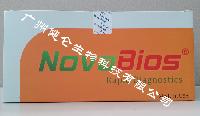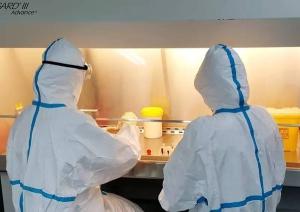


|



| 产地 | 美国 |
| 品牌 | Novabios |
| 货号 | NB3362 |
| 保存条件 | 2-30度 |
| 英文名称 | Zika rapid test |
| 保质期 | 18个月个月 |
Zika Virus IgG/IgM Ab Rapid Test
(Serum/Plasma/Whole Blood)
Instructions for Use Catalog Number: B815C
For professional in vitro diagnostic use only
A rapid and sensitive test for the qualitative detection and differentiation of IgG and IgM antibodies to Zika Virus in human serum, plasma or whole blood. For professional in vitro diagnostic use only.
 Intended Use
Intended Use
Zika Virus IgG/IgM Antibody Rapid Test is a qualitative lateral flow immunoassay for the simultaneous detection and differentiation of IgG and IgM antibodies to Zika Virus in human serum, plasma or whole blood. This test can be used for the presumptive distinction between a primary and secondary Zika Virus infection. This test is for In-Vitro Diagnostic use only. All results should be verified with other qualified assays.
Summary
Zika virus (ZIKV) is a mosquito-borne flavivirus that was first isolated from a rhesus monkey in the Zika forest of Uganda in 1947. In 1968, isolation from human hosts occurred in residents of Nigeria. Since then, multiple studies have confirmed ZIKV antibody in humans from a multitude of countries in Africa and parts of Asia. In 2015, ZIKV first appeared outside of Africa and Asia when it was isolated in Brazil where is has caused a minor outbreak following the 2014 FIFA World Cup. ZIKV is closely related to other mosquito-borne flaviviruses such as the dengue, yellow fever, West Nile, and Japanese encephalitis viruses. ZIKV causes a disease known as Zika fever, which is characterized by a macropapular rash covering the body, fever, joint pain, and malaise. Although there have yet to be serious complications arising from ZIKV, it's appearance across the globe, mosquito-driven transmission cycle, and possible spread via sexual contact make ZIKV an important emerging pathogen whose global impact is yet to be discovered.
Diagnosis for ZIKV infection include PCR tests to detect viral DNA as well as additional tests to detect ZIKV antibody (IgM) in serum. IgM for ZIKV is typically detectable around 3-5 days after infection, but cross-reactivity with closely related dengue, yellow fever, Japanese encephalitis, and West Nile viruses are possible. These cross-reactive results were more common in patients that denoted signs of previous flavivirus infection than patients with primary ZIKV infection. For best diagnosis practices, serum samples should be analyzed as early as possible with a second test 2 to 3 weeks after that.
Principle
Zika Virus IgG/IgM Rapid Test is a lateral flow chromatographic immunoassay. The test cassette consists of a pink colored conjugate pad containing recombinant (Zika NS1 protein & envelope protein) common antigens conjugated with colloid gold and rabbit IgG-gold conjugates, a nitrocellulose membrane strip containing two test bands (T1 and T2 bands) and a control band (C band). The T2 & T1 band is pre-coated with monoclonal anti-human IgM & IgG and the C band is pre-coated with goat anti rabbit IgG. When an adequate volume of test specimen is dispensed into the sample well of the cassette, the specimen migrates by capillary action across the cassette. Zika Virus IgM antibodies if present in the specimen will bind to the Zika conjugates. The immunocomplex is then captured on the membrane by the pre-coated anti-human IgM antibody, forming a burgundy colored T1 band, indicating a Zika Virus IgM positive test result. Zika virus IgG antibodies if present in the specimen will bind to the Zika conjugates. Absence of any test bands (T1 and T2) suggests a negative result. The test contains an internal control (C band) which should exhibit a burgundy colored band of the immunocomplex of goat anti rabbit IgG/rabbit IgG-gold conjugate regardless of the color development on any of the test bands. Otherwise, the test result is invalid and the specimen must be retested with another device. Since a single serum in the acute phase is presumptive, it is recommended that a second sample be taken 1–2 weeks after the first sample to demonstrate seroconversion (negative to positive) or an increase on the antibody titer
In primary infections (first infection with a flavivirus) it has been demonstrated that antibodies cross-reaction is minimal with other genetically related viruses. However, it has been demonstrated that sera of individuals with a previous history of infection from other flaviviruses (especially dengue, yellow fever and West Nile) can cross-react in these tests. Although neutralization by plaque reduction (PRNT) offers a greater specificity in the detection of neutralizing antibodies (IgG), cross-reactions have also been documented; in fact, some patients with a previous history of infection by other flaviviruses have shown up to a fourfold increase in neutralizing antibody titers when infected with ZIKV. It is highly recommended that suspected patients with Zika Virus infection be also tested for dengue and chikungunya
Precautions
? For professional in vitro diagnostic use only. Do not use after the expiration date.
? For single use only.
? The test should remain in the sealed pouch until use.
? All specimens should be considered potentially hazardous and handled in the same manner as infectious agents.
? The test should be discarded in a proper biohazard container after testing.
? Optimal assay performance requires strict adherence to the assay procedure described in this Instruction sheet and any deviations from the procedure may lead to aberrant results.
Storage & Stability
Store as packaged in the sealed pouch at 4 - 30°C and not in direct sunlight. The test is stable through the expiration date printed on the sealed pouch. The test must remain in the sealed pouch until use. DO NOT FREEZE. Do not use beyond the expiration date.
Materials
Materials Provided:
? Test Cassette Device in a sealed pouch (25 Cassettes)
? Instructions for Use
? Diluent Buffer (3ml)
Specimen Collection & Preparation
? Separate the serum or plasma from blood as soon as possible to avoid hemolysis. Only clear, non-hemolyzed specimens can be used.
? Testing should be performed immediately after the specimens have been collected. Do not leave the specimens at room temperature for prolonged periods. Specimens may be stored at 2-8°C for up to 3 days. For long-term storage, specimens should be kept below -20°C.
? Bring specimens to room temperature prior to testing. Frozen specimens must be completely thawed and mixed well prior to testing. Specimens should not be frozen and thawed repeatedly.
? If specimens are to be shipped, they should be packed in compliance with federal regulations for the transportation of etiologic agents.
Directions for Use:
Allow the test device, specimen and/or buffer to equilibrate at room temperature (15-30°C) before testing.
1. Bring the pouch to room temperature before opening it. Remove the test device from the sealed pouch and use it as soon as possible.
2. Place the test device on a clean and level surface. Pipette 25μL of serum, plasma or whole blood into the sample well of the test cassette.
Catalog: B814C Rev.01/2016
3. Immediately add 2 drops of diluent buffer to sample well.
4. Wait for the red line(s) to appear. The test result should be read between 15 and 20 minutes.
Note: Do not interpret the result after 30 minutes.
Interpretation of Results:
(Please refer to the illustration)
IgM POSITIVE: Two distinct red lines appear. The control line (C) and IgM (M) line are visible on the test cassette. The test is positive for anti- Zika Virus IgM antibodies
IgG POSITIVE: Two distinct red lines appear. The control line (C) and IgG (G) line are visible on the test cassette. The test is positive for anti-Zika Virus IgG antibodies.
IgM and IgG POSITIVE: Three distinct red lines appear. The control line (C), IgM (M) and IgG (G) lines are visible on the test cassette. The test is positive for anti-Zika Virus IgM and IgG antibodies.
NEGATIVE: One distinct red line appears. The control line (C) is the only line visible on the test cassette. No Zika Virus IgM antibodies were detected. The result does not exclude Zika Virus infection. A new sample should be drawn from the patient in 3-5 days and then should be retested.
INVALID: Control line fails to appear. The test results are INVALID, if no control line (C) is visible, regardless of the presence or absence of lines in the IgG (G) or IgM (M) region of the cassette. Repeat the test using a new cassette.
NOTE: The intensity of the red color in the test line regions (G) and (M) will vary depending on the concentration of IgG and IgM present in the specimen. However, neither the quantitative value nor the rate of increase in IgG or IgM can be determined by this qualitative test.
Performance Characteristics
The overall sensitivity of Biocan Tell Me Fast Zika Virus IgG/IgM Antibody Rapid Test is still under examination and specificity is 99.5%. Currently we recommend the usage of this test for only preliminary presumptive screening purposes (research use only).
Cross Reactivity
In primary infections (first infection with a flavivirus) it has been demonstrated that antibodies cross-reaction is minimal with other genetically related viruses. However, it has been demonstrated that sera of individuals with a previous history of infection from other flaviviruses (especially dengue, yellow fever and West Nile) can cross-react in these tests. Although neutralization by plaque reduction (PRNT) offers a greater specificity in the detection of neutralizing antibodies (IgG), cross-reactions have also been documented; in fact, some patients with a previous history of infection by other flaviviruses have shown up to a fourfold increase in neutralizing antibody titers when infected with ZIKV. It is highly recommended that suspected patients with Zika Virus infection be also tested for dengue and chikungunya.
Extensive testing has been performed on Biocan Zika IgG/igM Ab Test with Dengue and Chikungunya IgG & IgM positive samples from low to high titer and no cross reactivity has been observed.
Quality Control
A procedural control is included in the test. A red line appearing in the control region (C) is the internal procedural control. It confirms sufficient specimen volume and correct procedural technique. A clear background is also required.
Refrences
Gourinat AC, O’Connor O, Calvez E, Goarant C, Dupont-Rouzeyrol M: Detection of Zika Virus in Urine. Emerging Infectious Diseases 2015, 21:84-6.
Emerging Infectious Diseases 2009, 15:1347-50. European Center for Disease Prevention and Control. Rapid Risk Assessment. Zika virus infection outbreak, French Polynesia. 2014.
Storage temperature
Lot number
In vitro diagnostic device
Expiry date
Read instruction before use
Manufacturer
Protect from light and moisture
Do not reuse GuangZhou JianLun Biotech Co.,Ltd.
【公司名称】 广州健仑生物科技有限公司
【联系电话】 020-82574011 13802525278
【公司传真】 020-32206070
【电子邮件】 Service@jianlun.com
【腾讯 QQ 】 2042552662
【公司地址】 广州清华科技园创新基地番禺石楼镇创启路63号二期2幢101-103室